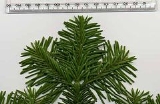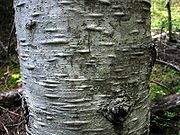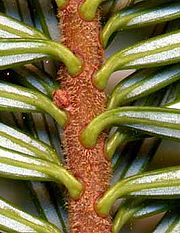
Pacific Silver Fir
Encyclopedia
Abies amabilis, commonly known as the Pacific silver fir, is a fir
native to the Pacific Northwest
of North America
, occurring in the Pacific Coast Ranges
and the Cascade Range
from the extreme southeast of Alaska
, through western British Columbia
, Washington and Oregon
, to the extreme northwest of California
. It is also commonly referred to as the white fir, red fir, lovely fir, amabilis fir, Cascades fir, or silver fir. It grows at altitudes of sea level to 1,500 m in the north of the range, and 1,000-2,300 m in the south of the range, always in temperate rain forest
with relatively high precipitation and cool, humid summers. Common associate trees are Douglas fir and California buckeye.

 It is a large evergreen
It is a large evergreen
coniferous
tree
growing to 30–45 m (exceptionally 72 m) tall and with a trunk diameter of up to 1.2 m (exceptionally 2.3 m). The bark
on younger trees is light grey, thin and covered with resin
blisters. On older trees, it darkens and develops scales and furrows. The leaves
are needle-like, flattened, 2-4.5 cm long and 2 mm wide by 0.5 mm thick, matt dark green above, and with two white bands of stomata below, and slightly notched at the tip. The leaf arrangement is spiral on the shoot, but with each leaf variably twisted at the base so they lie flat to either side of and above the shoot, with none below the shoot. The shoots are orange-red with dense velvety pubescence. The cones
are 9–17 cm long and 4–6 cm broad, dark purple before maturity; the scale bracts are short, and hidden in the closed cone. The winged seed
s are released when the cones disintegrate at maturity about 6–7 months after pollination.
Pacific Silver Fir is very closely related to Maries' Fir
A. mariesii from Japan
, which is distinguished by its slightly shorter leaves (1.5-2.5 cm) and smaller cones (5–11 cm long).
is soft and not very strong; it is used for paper
making, packing crates and other cheap construction work. The foliage has an attractive scent, and is sometimes used for Christmas
decoration, including Christmas tree
s.
It is also planted as an ornamental tree in large parks, though its requirement for cool, humid summers limits the areas where it grows well; successful growth away from its native range is restricted to areas like western Scotland
and southern New Zealand
.
Fir
Firs are a genus of 48–55 species of evergreen conifers in the family Pinaceae. They are found through much of North and Central America, Europe, Asia, and North Africa, occurring in mountains over most of the range...
native to the Pacific Northwest
Pacific Northwest
The Pacific Northwest is a region in northwestern North America, bounded by the Pacific Ocean to the west and, loosely, by the Rocky Mountains on the east. Definitions of the region vary and there is no commonly agreed upon boundary, even among Pacific Northwesterners. A common concept of the...
of North America
North America
North America is a continent wholly within the Northern Hemisphere and almost wholly within the Western Hemisphere. It is also considered a northern subcontinent of the Americas...
, occurring in the Pacific Coast Ranges
Pacific Coast Ranges
The Pacific Coast Ranges and the Pacific Mountain System are the series of mountain ranges that stretch along the West Coast of North America from Alaska south to Northern and Central Mexico...
and the Cascade Range
Cascade Range
The Cascade Range is a major mountain range of western North America, extending from southern British Columbia through Washington and Oregon to Northern California. It includes both non-volcanic mountains, such as the North Cascades, and the notable volcanoes known as the High Cascades...
from the extreme southeast of Alaska
Alaska
Alaska is the largest state in the United States by area. It is situated in the northwest extremity of the North American continent, with Canada to the east, the Arctic Ocean to the north, and the Pacific Ocean to the west and south, with Russia further west across the Bering Strait...
, through western British Columbia
British Columbia
British Columbia is the westernmost of Canada's provinces and is known for its natural beauty, as reflected in its Latin motto, Splendor sine occasu . Its name was chosen by Queen Victoria in 1858...
, Washington and Oregon
Oregon
Oregon is a state in the Pacific Northwest region of the United States. It is located on the Pacific coast, with Washington to the north, California to the south, Nevada on the southeast and Idaho to the east. The Columbia and Snake rivers delineate much of Oregon's northern and eastern...
, to the extreme northwest of California
California
California is a state located on the West Coast of the United States. It is by far the most populous U.S. state, and the third-largest by land area...
. It is also commonly referred to as the white fir, red fir, lovely fir, amabilis fir, Cascades fir, or silver fir. It grows at altitudes of sea level to 1,500 m in the north of the range, and 1,000-2,300 m in the south of the range, always in temperate rain forest
Temperate rain forest
Temperate rainforests are coniferous or broadleaf forests that occur in the temperate zone and receive high rainfall.-Definition:For temperate rain forests of North America, Alaback's definition is widely recognized:-Global distribution:...
with relatively high precipitation and cool, humid summers. Common associate trees are Douglas fir and California buckeye.
Description


Evergreen
In botany, an evergreen plant is a plant that has leaves in all seasons. This contrasts with deciduous plants, which completely lose their foliage during the winter or dry season.There are many different kinds of evergreen plants, both trees and shrubs...
coniferous
Pinophyta
The conifers, division Pinophyta, also known as division Coniferophyta or Coniferae, are one of 13 or 14 division level taxa within the Kingdom Plantae. Pinophytes are gymnosperms. They are cone-bearing seed plants with vascular tissue; all extant conifers are woody plants, the great majority being...
tree
Tree
A tree is a perennial woody plant. It is most often defined as a woody plant that has many secondary branches supported clear of the ground on a single main stem or trunk with clear apical dominance. A minimum height specification at maturity is cited by some authors, varying from 3 m to...
growing to 30–45 m (exceptionally 72 m) tall and with a trunk diameter of up to 1.2 m (exceptionally 2.3 m). The bark
Bark
Bark is the outermost layers of stems and roots of woody plants. Plants with bark include trees, woody vines and shrubs. Bark refers to all the tissues outside of the vascular cambium and is a nontechnical term. It overlays the wood and consists of the inner bark and the outer bark. The inner...
on younger trees is light grey, thin and covered with resin
Resin
Resin in the most specific use of the term is a hydrocarbon secretion of many plants, particularly coniferous trees. Resins are valued for their chemical properties and associated uses, such as the production of varnishes, adhesives, and food glazing agents; as an important source of raw materials...
blisters. On older trees, it darkens and develops scales and furrows. The leaves
Leaf
A leaf is an organ of a vascular plant, as defined in botanical terms, and in particular in plant morphology. Foliage is a mass noun that refers to leaves as a feature of plants....
are needle-like, flattened, 2-4.5 cm long and 2 mm wide by 0.5 mm thick, matt dark green above, and with two white bands of stomata below, and slightly notched at the tip. The leaf arrangement is spiral on the shoot, but with each leaf variably twisted at the base so they lie flat to either side of and above the shoot, with none below the shoot. The shoots are orange-red with dense velvety pubescence. The cones
Conifer cone
A cone is an organ on plants in the division Pinophyta that contains the reproductive structures. The familiar woody cone is the female cone, which produces seeds. The male cones, which produce pollen, are usually herbaceous and much less conspicuous even at full maturity...
are 9–17 cm long and 4–6 cm broad, dark purple before maturity; the scale bracts are short, and hidden in the closed cone. The winged seed
Seed
A seed is a small embryonic plant enclosed in a covering called the seed coat, usually with some stored food. It is the product of the ripened ovule of gymnosperm and angiosperm plants which occurs after fertilization and some growth within the mother plant...
s are released when the cones disintegrate at maturity about 6–7 months after pollination.
Pacific Silver Fir is very closely related to Maries' Fir
Maries' Fir
Maries' Fir is a fir native to the mountains of central and northern Honshū, Japan...
A. mariesii from Japan
Japan
Japan is an island nation in East Asia. Located in the Pacific Ocean, it lies to the east of the Sea of Japan, China, North Korea, South Korea and Russia, stretching from the Sea of Okhotsk in the north to the East China Sea and Taiwan in the south...
, which is distinguished by its slightly shorter leaves (1.5-2.5 cm) and smaller cones (5–11 cm long).
Uses
The woodWood
Wood is a hard, fibrous tissue found in many trees. It has been used for hundreds of thousands of years for both fuel and as a construction material. It is an organic material, a natural composite of cellulose fibers embedded in a matrix of lignin which resists compression...
is soft and not very strong; it is used for paper
Paper
Paper is a thin material mainly used for writing upon, printing upon, drawing or for packaging. It is produced by pressing together moist fibers, typically cellulose pulp derived from wood, rags or grasses, and drying them into flexible sheets....
making, packing crates and other cheap construction work. The foliage has an attractive scent, and is sometimes used for Christmas
Christmas
Christmas or Christmas Day is an annual holiday generally celebrated on December 25 by billions of people around the world. It is a Christian feast that commemorates the birth of Jesus Christ, liturgically closing the Advent season and initiating the season of Christmastide, which lasts twelve days...
decoration, including Christmas tree
Christmas tree
The Christmas tree is a decorated evergreen coniferous tree, real or artificial, and a tradition associated with the celebration of Christmas. The tradition of decorating an evergreen tree at Christmas started in Livonia and Germany in the 16th century...
s.
It is also planted as an ornamental tree in large parks, though its requirement for cool, humid summers limits the areas where it grows well; successful growth away from its native range is restricted to areas like western Scotland
Scotland
Scotland is a country that is part of the United Kingdom. Occupying the northern third of the island of Great Britain, it shares a border with England to the south and is bounded by the North Sea to the east, the Atlantic Ocean to the north and west, and the North Channel and Irish Sea to the...
and southern New Zealand
New Zealand
New Zealand is an island country in the south-western Pacific Ocean comprising two main landmasses and numerous smaller islands. The country is situated some east of Australia across the Tasman Sea, and roughly south of the Pacific island nations of New Caledonia, Fiji, and Tonga...
.

